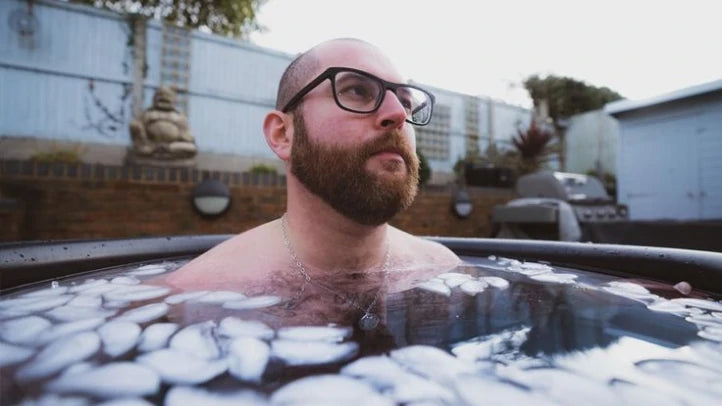Introduction
Celebrities and influencers are praising the benefits of cold plunging, but does the science live up to the hype? This article breaks down what happens to the body in cold water and what that means for you. Let's dive into the fascinating world of ice baths and explore why they've become a wellness trend.

What Are Ice Baths?
An ice bath is a therapy where the body is immersed in ice-cold water, typically between 10 and 15 °C (50 and 59 °F). The cold temperature causes blood vessels to constrict, reducing blood flow to the affected areas and decreasing swelling and inflammation. Individuals, especially those in endurance sports or weightlifting, often use ice baths as part of their recovery routine.
Historical Background
The ice bath wellness trend has gained momentum in the past few months. Celebrities like LeBron James, Kim Kardashian, Virat Kohli, Kevin Hart, Jake Gyllenhaal and Lady Gaga have highlighted the rewarding benefits of submerging oneself in frosty waters. However, ice baths are not a recent discovery. They have been part of wellness regimes since ancient civilizations. In fact, ice baths are mentioned in the journals of Hippocrates from the Greek civilization and in ancient Ayurvedic texts.

(Jake Gyllenhaal)
Benefits of Ice Baths
Ice baths offer numerous benefits that can enhance physical and mental health. Here are some of the most notable advantages:
-
Muscle Recovery
- Ice baths help reduce muscle soreness and accelerate recovery by constricting blood vessels and reducing inflammation. This is particularly beneficial after intense workouts.
-
Inflammation Reduction
- The cold temperature decreases inflammation by reducing blood flow and numbing the affected tissues, aiding in quicker recovery.
-
Weight Loss
- Cold exposure can activate brown fat, which burns calories to generate heat, potentially aiding in weight loss.
-
Mental Health
- Ice baths can trigger the release of endorphins, improving mood and reducing stress and anxiety.
-
Improved Circulation
- Alternating between cold and warm temperatures can enhance blood flow and improve circulation.
-
Enhanced Immune Function
- Cold exposure may boost the immune system by increasing the production of white blood cells.
-
Insulin Sensitivity
- Ice baths may improve insulin sensitivity, helping regulate blood sugar levels.

(Chris Hemsworth)
Muscle Recovery with Ice Baths
Ice baths are widely used by athletes for muscle recovery. The cold water helps reduce muscle damage and soreness by constricting blood vessels and decreasing metabolic activity, which reduces swelling and tissue breakdown.
Inflammation Reduction with Ice Baths
Ice baths effectively reduce inflammation by limiting the inflammatory response in the body. The cold temperature constricts blood vessels, which helps decrease swelling and flushes out inflammatory substances.
Ice Baths for Athletes
Athletes use ice baths to enhance recovery and improve performance. The cold therapy helps reduce muscle fatigue and soreness, allowing athletes to train harder and recover faster. This is particularly beneficial for endurance athletes who engage in high-intensity training.
Ice Baths for Weight Loss
Cold exposure activates brown fat, which burns calories to generate heat. This can help with weight loss by increasing calorie expenditure. Additionally, ice baths can improve insulin sensitivity, aiding in better regulation of blood sugar levels.
Mental Health Benefits of Ice Baths
Ice baths can positively affect mental health by triggering the release of endorphins, which are natural mood boosters. This can reduce stress and anxiety, promoting a sense of well-being and relaxation. Ice baths can also improve sleep quality, which is essential for overall mental health.
Improved Circulation
Ice baths improve circulation by constricting blood vessels and reducing blood flow initially, followed by a period of increased blood flow as the body re-warms. This process helps deliver oxygen and nutrients to muscles and tissues, enhancing recovery and overall health.
Immune Boosting Ice Baths
Cold exposure from ice baths can enhance immune function by increasing the number and activity of immune cells. This can help the body fight off infections and diseases more effectively.
Insulin Sensitivity and Cold Plunges
Ice baths can improve insulin sensitivity, helping the body regulate blood sugar levels more effectively. This is particularly beneficial for individuals with metabolic disorders or those looking to improve their metabolic health.

(Kevin Hart)
Cold Plunge Techniques
To maximize the benefits of ice baths, it's important to use proper techniques. Start by filling a bathtub with cold water and adding ice. Gradually immerse yourself in the water, starting with your feet and working your way up. Stay in the ice bath for 10-15 minutes, but listen to your body and get out if you feel too uncomfortable.
Ice Bath Safety Tips
While ice baths can be beneficial, it's important to take safety precautions. Start with shorter durations and gradually increase your time in the cold water. Avoid prolonged exposure to prevent hypothermia. Always listen to your body and consult a healthcare professional if you have any medical conditions.
Optimal Timing for Ice Baths
The best time to take an ice bath is immediately after a workout to reduce muscle soreness and inflammation. However, ice baths can also be taken later in the day for relaxation and mental health benefits. Experiment with different timings to find what works best for you.
Proper Technique for Taking an Ice Bath
To take an ice bath, fill a bathtub with cold water and add ice until the water temperature is between 10-15°C (50-59°F). Immerse yourself in the water, starting with your feet and slowly lowering your body. Stay in the ice bath for 10-15 minutes, but get out if you feel too uncomfortable.
How Long Should You Stay in an Ice Bath?
The optimal duration for an ice bath is 10-15 minutes. This allows enough time for the cold to constrict blood vessels and reduce inflammation without causing too much discomfort. However, individual tolerance varies, so listen to your body and adjust the duration as needed.
Frequency of Ice Baths
The frequency of ice baths depends on your individual needs and goals. For athletes or those engaging in intense physical activity, ice baths once or twice a week can be beneficial. However, beginners should start with shorter durations and gradually increase the frequency as they become more accustomed to the cold.
Ice Baths for Muscle Pain
Ice baths can help alleviate muscle pain by reducing inflammation and numbing the affected areas. This can be particularly beneficial for individuals experiencing delayed-onset muscle soreness (DOMS) after intense workouts.
Ice Bath for Endurance Training
Endurance athletes often use ice baths to enhance recovery and improve performance. The cold therapy helps reduce muscle fatigue and soreness, allowing athletes to train harder and recover faster.
Ice Baths and Sexual Health
Ice baths can enhance sexual health by improving blood flow and boosting libido. The cold temperature increases blood flow to the reproductive organs, which can enhance sexual wellness and performance.
Ice Baths and Stress Reduction
Ice baths can help reduce stress by triggering the release of endorphins and promoting relaxation. The cold exposure can also improve sleep quality, which is essential for overall mental health.
Peripheral Circulation Improvement
Ice baths improve peripheral circulation by constricting blood vessels and then increasing blood flow as the body re-warms. This process helps deliver oxygen and nutrients to muscles and tissues, enhancing recovery and overall health.
Brown Fat Activation
Cold exposure from ice baths activates brown fat, which burns calories to generate heat. This can help with weight loss and improve metabolic health by increasing calorie expenditure.
Cold Exposure Therapy
Cold exposure therapy includes various methods like ice baths, cold showers, and cryotherapy. These methods can help reduce inflammation, improve circulation, and enhance mental health.
Faster Recovery with Cold Exposure
Cold exposure can speed up recovery by reducing inflammation and promoting blood flow. This helps deliver essential nutrients and oxygen to damaged tissues, aiding in healing and recovery.
Psychological Benefits of Ice Baths
Ice baths can enhance mental health by triggering the release of endorphins, which are natural mood boosters. This can reduce stress, anxiety, and depression, promoting a sense of well-being and relaxation.
Ice Bath Routine
Creating an effective ice bath routine involves gradually increasing the duration and frequency of ice baths. Start with shorter durations and less frequent sessions, and gradually build up as your body becomes more accustomed to the cold.
Ice Bath for Improved Performance
Ice baths can enhance performance by reducing muscle soreness and fatigue. This allows athletes to train harder and recover faster, improving overall performance and endurance.
Cold Water Immersion Therapy
Cold water immersion therapy includes ice baths and other methods of cold exposure. This therapy can help reduce inflammation, improve circulation, and enhance mental health.
Ice Bath Tips for Beginners
For beginners, it's important to start with shorter durations and gradually increase the time spent in the ice bath. Listen to your body and get out if you feel too uncomfortable. Always consult a healthcare professional if you have any medical conditions.
Environmental Impact of Cold Plunges
Cold plunges require significant water and energy, impacting the environment. To minimize the environmental impact, consider using recycled or reused water and limiting the frequency of cold plunges.




